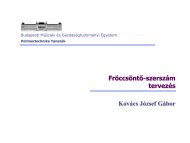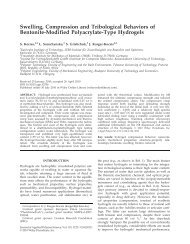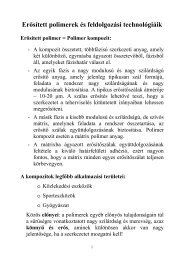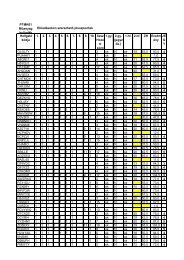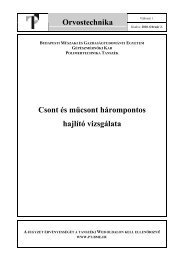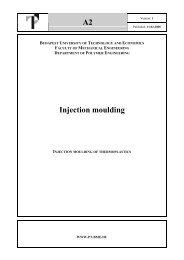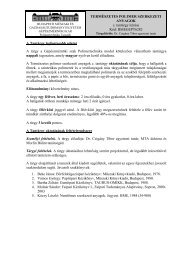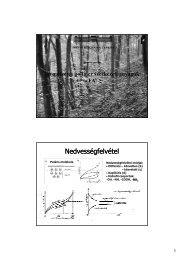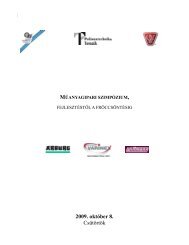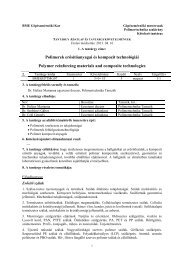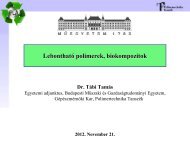Flexural creep of all-polypropylene composites: Model analysis
Flexural creep of all-polypropylene composites: Model analysis
Flexural creep of all-polypropylene composites: Model analysis
You also want an ePaper? Increase the reach of your titles
YUMPU automatically turns print PDFs into web optimized ePapers that Google loves.
TABLE 2.Parameters obtained from the Burger model.SpecimenTemperature(8C)E 1(MPa)E 2(MPa)g 1(GPa-s)g 2(GPa-s)FIG. 4. Creep strain master curves generated for <strong>all</strong>-PP <strong>composites</strong>with unidirectional (UD) and cross-ply (CP) lay-ups; T ref is the referencetemperature.with increasing temperature. The negative sign indicates ashift to the right <strong>of</strong> the <strong>creep</strong> curves, that is, toward thereference at lower temperature. A higher shift value thusindicates a larger shifting <strong>of</strong> the <strong>creep</strong> curve to the referencecurve. The shifting scheme indicates that as temperatureincreases, molecular relaxation accumulate at a constantrate and that the underlying mechanism <strong>of</strong> <strong>creep</strong>remains unchanged.Creep <strong>Model</strong>ing AnalysisSimulated <strong>creep</strong> curves using the Burger model arealso shown in Fig. 1 with the solid lines. It can be seenthat they show a satisfactory agreement with the experimentaldata at each temperature. The first instantaneousdeformation arises from the spring or the elastic element(E 1 ) and later time-dependent deformation comes fromthe par<strong>all</strong>el spring and dashpot (g 2 ) and from the viscousdashpot flow (g 1 ). The model parameters obtained for the<strong>all</strong>-PP <strong>composites</strong> produced by unidirectional and crossplylay-ups are shown in Table 2. According to theseresults, viscosity decreased with increase in the <strong>creep</strong> testtemperature and higher flow occurred in the dashpot andpermanent deformation increased. In the viscous part, g 2TABLE 1.Temperature (8C)Shift factor (log a T ) for the UD and CP <strong>all</strong>-PP <strong>composites</strong>.UDlog a T20 1.16 1.06730 0 040 21.215 21.14850 22.304 21.95160 23.151 22.51270 23.786 22.99880 24.426 23.501CPUD 20 1.22 6.37 12.11 0.4230 1.10 4.30 10.00 0.2540 0.94 2.67 5.00 0.1550 0.78 1.74 2.50 0.1060 0.66 1.40 2.00 0.0770 0.55 1.20 1.67 0.0780 0.48 1.09 1.11 0.06CP 20 0.49 2.39 3.33 0.1530 0.44 1.57 2.00 0.1040 0.38 0.91 1.25 0.0650 0.33 0.68 1.11 0.0360 0.29 0.63 1.10 0.0270 0.25 0.62 1.07 0.0280 0.23 0.62 1.00 0.02tends to decrease with the increase in the temperatureconfirming that the rise in temperature increases the mobility<strong>of</strong> the polymer chains. The modulus (E 1 ) <strong>of</strong> theMaxwell spring showed a decreasing function with temperature,which can be attributed to the s<strong>of</strong>tening <strong>of</strong> thematerial at elevated temperature and the stiffness thusdecreased with diminished instantaneous modulus. Thisindicates that the plastic deformation becomes severe atelevated temperature. The retardant elasticity (E 2 ) and viscosity(g 2 ) showed a similar dependency on temperature,thus decreasing with increasing temperature. It could bealternatively stated that the deformation <strong>of</strong> the Kelvin-Voigt unit increased with increasing temperature. InterestinglyTable 2 also shows that the variation in the tapelay-up has a significant effect on the viscous and elasticcomponents <strong>of</strong> the Burger model as they were found tobe higher for UD than for the CP composite specimens.This arises from the difference in the microstructures andthe tape lay-up. It strongly suggests that the variationin the reinforcement architecture has a significant effect onthe viscoelastic properties. Because <strong>of</strong> the higher viscousflow and lower elastic modulus, CP composite specimensdeform more than that <strong>of</strong> the UD counterpart under thesame loading condition.The results mentioned earlier thus shows that the Burgermodel provides a constitutive representation <strong>of</strong> <strong>creep</strong><strong>of</strong> the <strong>all</strong>-PP <strong>composites</strong> and from the modeling parameterstheir structure-to-property relationship can be betterrealized. Addition<strong>all</strong>y, an empirical equation, Findleypower law, is frequently applied to simulate and predictthe long-term <strong>creep</strong> properties due to its simple expressionand satisfactory applicability [7]. In this case, themethod was adopted to provide a broad understanding <strong>of</strong>the <strong>all</strong>-PP <strong>composites</strong>. The simulated curves (representedby solid lines) <strong>of</strong> the <strong>all</strong>-PP <strong>composites</strong> produced by differenttape lay-ups are shown in Fig. 5. It can be seen thatthey agree well with the experimental data at each temperatureand the power law can be used as a predictivemodel for <strong>creep</strong>. The complete modeling parameters e 0 ,DOI 10.1002/pen POLYMER ENGINEERING AND SCIENCE—-2008 945




